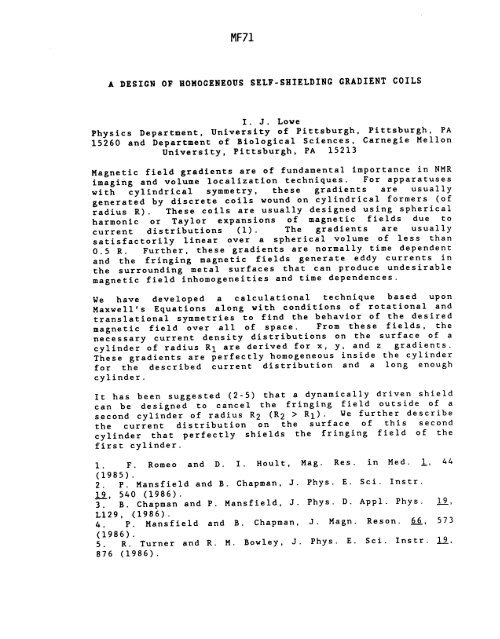th - 1987 - 51st ENC Conference
th - 1987 - 51st ENC Conference
th - 1987 - 51st ENC Conference
You also want an ePaper? Increase the reach of your titles
YUMPU automatically turns print PDFs into web optimized ePapers that Google loves.
MF71<br />
A DESIGN OF HOMOGENEOUS SELF-SHIELDING GRADIENT COILS<br />
I. J. Lowe<br />
Physics Department, University of Pittsburgh, Pittsburgh, PA<br />
15260 and Department of Biological Sciences, Carnegie Mellon<br />
University, Pittsburgh, PA 15213<br />
Magnetic field gradients are of fundamental importance in NMR<br />
imaging and volume localization techniques. For apparatuses<br />
wi<strong>th</strong> cylindrical symmetry, <strong>th</strong>ese gradients are usually<br />
generated by discrete coils wound on cylindrical formers (of<br />
radius R). These coils are usually designed using spherical<br />
harmonic or Taylor expansions of magnetic fields due to<br />
current distributions (I). The gradients are usually<br />
satisfactorily linear over a spherical volume of less <strong>th</strong>an<br />
0.5 R. Fur<strong>th</strong>er, <strong>th</strong>ese gradients are normally time dependent<br />
and <strong>th</strong>e fringing magnetic fields generate eddy currents in<br />
<strong>th</strong>e surrounding metal surfaces <strong>th</strong>at can produce undesirable<br />
magnetic field inhomogeneities and time dependences.<br />
We have developed a calculational technique based upon<br />
Maxwell's Equations along wi<strong>th</strong> conditions of rotational and<br />
translational symmetries to find <strong>th</strong>e behavior of <strong>th</strong>e desired<br />
magnetic field over all of space. From <strong>th</strong>ese fields, <strong>th</strong>e<br />
necessary current density distributions on <strong>th</strong>e surface of a<br />
cylinder of radius R I are derived for x, y, and z gradients.<br />
These gradients are perfectly homogeneous inside <strong>th</strong>e cylinder<br />
for <strong>th</strong>e described current distribution and a long enough<br />
cylinder.<br />
It has been suggested (2-5) <strong>th</strong>at a dynamically driven shield<br />
can be designed to cancel <strong>th</strong>e fringing field outside of a<br />
second cylinder of radius R 2 (R 2 > RI). We fur<strong>th</strong>er describe<br />
<strong>th</strong>e current distribution on <strong>th</strong>e surface of <strong>th</strong>is second<br />
cylinder <strong>th</strong>at perfectly shields <strong>th</strong>e fringing field of <strong>th</strong>e<br />
first cylinder.<br />
I. F. Romeo and D. I. Hoult, Hag. Res. in Med. ~, &4<br />
(1985).<br />
2. p. Mansfield and B. Chapman, J. Phys. E. Sci. Instr.<br />
I__99, 540 (1986).<br />
3. B. Chapman and P. Mansfield, J. Phys. D. Appl. Phys. I__99,<br />
L129, (1986).<br />
4. P. Mansfield and B. Chapman, J. Magn. Reson. 66, 573<br />
(1986).<br />
5. R. Turner and R. M. Bowley, J. Phys. E. Sci. Instr. I__99,<br />
876 (1986).













